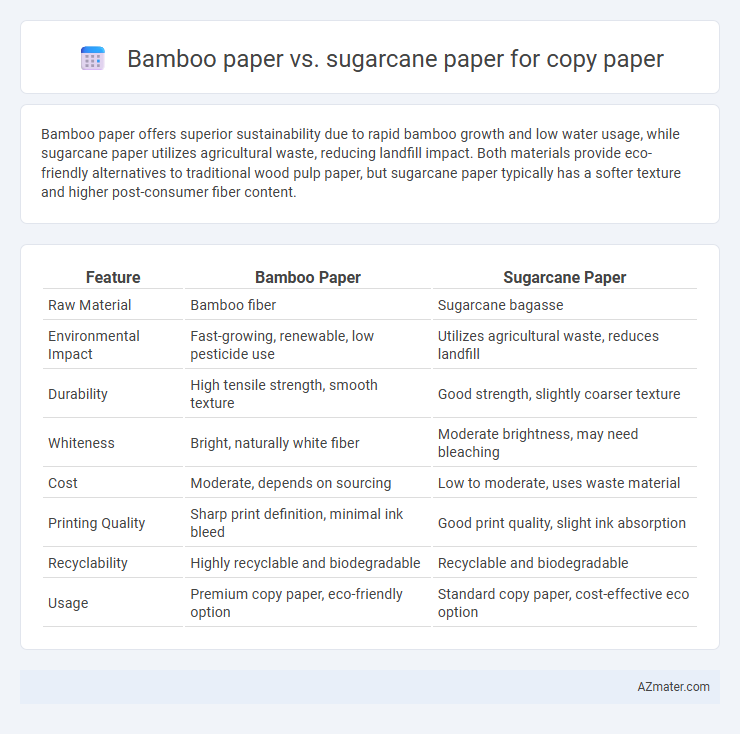Bamboo paper offers superior sustainability due to rapid bamboo growth and low water usage, while sugarcane paper utilizes agricultural waste, reducing landfill impact. Both materials provide eco-friendly alternatives to traditional wood pulp paper, but sugarcane paper typically has a softer texture and higher post-consumer fiber content.
Table of Comparison
| Feature | Bamboo Paper | Sugarcane Paper |
|---|---|---|
| Raw Material | Bamboo fiber | Sugarcane bagasse |
| Environmental Impact | Fast-growing, renewable, low pesticide use | Utilizes agricultural waste, reduces landfill |
| Durability | High tensile strength, smooth texture | Good strength, slightly coarser texture |
| Whiteness | Bright, naturally white fiber | Moderate brightness, may need bleaching |
| Cost | Moderate, depends on sourcing | Low to moderate, uses waste material |
| Printing Quality | Sharp print definition, minimal ink bleed | Good print quality, slight ink absorption |
| Recyclability | Highly recyclable and biodegradable | Recyclable and biodegradable |
| Usage | Premium copy paper, eco-friendly option | Standard copy paper, cost-effective eco option |
Introduction to Sustainable Paper Alternatives
Bamboo paper and sugarcane paper represent innovative sustainable alternatives to traditional copy paper, offering eco-friendly solutions that reduce deforestation and environmental impact. Bamboo paper is derived from fast-growing bamboo plants that require minimal water and no pesticides, while sugarcane paper leverages agricultural waste, particularly bagasse, promoting waste valorization. Both options deliver comparable print quality for office use while significantly lowering carbon footprint and conserving natural resources.
What is Bamboo Paper?
Bamboo paper is made from the cellulose fibers of bamboo plants, offering an eco-friendly alternative to traditional wood pulp paper with rapid renewability and strong fiber qualities that enhance durability and smoothness. Unlike sugarcane paper, which utilizes bagasse, the fibrous residue remaining after juice extraction, bamboo paper typically provides a higher tensile strength and natural antibacterial properties. Its sustainable sourcing and reduced environmental impact make bamboo paper a preferred choice in copy paper production for businesses seeking greener office supplies.
What is Sugarcane Paper?
Sugarcane paper is an eco-friendly alternative made from bagasse, the fibrous residue left after extracting juice from sugarcane stalks, offering a sustainable solution for copy paper production. It requires less water and energy compared to traditional wood pulp, reducing environmental impact while maintaining comparable strength and print quality. Sugarcane paper's renewable resource base and lower carbon footprint make it a preferred choice for businesses seeking green office supplies.
Environmental Impact: Bamboo vs Sugarcane
Bamboo paper production consumes less water and regenerates rapidly, making it a highly sustainable option for copy paper with a lower carbon footprint compared to sugarcane paper. Sugarcane paper, derived from agricultural waste, also reduces reliance on wood pulp but often involves higher energy inputs during processing. Both alternatives contribute to deforestation reduction, yet bamboo's faster growth rate and minimal pesticide use position it as a more eco-friendly choice in environmental impact assessments.
Production Process Comparison
Bamboo paper production involves harvesting fast-growing bamboo, which is then mechanically or chemically processed into pulp with minimal water and chemical use, resulting in a sustainable and biodegradable product. Sugarcane paper, derived from sugarcane bagasse, utilizes an agricultural byproduct that undergoes pulping with lower energy consumption and reduced waste output, making it an eco-friendly alternative. Comparing both, bamboo paper offers rapid renewability due to bamboo's fast growth cycle, while sugarcane paper leverages waste reduction from sugar production, highlighting distinct environmental benefits in their respective production processes.
Quality and Performance for Copy Paper Use
Bamboo paper offers superior durability and smooth texture, resulting in consistently high-quality print resolution and reduced jamming in copy machines. Sugarcane paper provides excellent brightness and environmental benefits but may exhibit slightly lower strength and a rougher finish, affecting performance during high-volume printing. Both papers are eco-friendly alternatives, with bamboo paper often preferred for premium copy paper applications due to its robustness and reliable feed characteristics.
Cost and Market Availability
Bamboo paper generally commands a higher price than sugarcane paper due to its sustainable cultivation and processing methods, though it offers superior durability and eco-friendliness. Sugarcane paper proves to be more cost-effective and widely available in mass markets, benefiting from sugar industry byproducts and established production infrastructure. Both options cater to increasing demand for sustainable copy paper, with sugarcane paper leading in affordability and bamboo paper favored for premium, eco-conscious segments.
Biodegradability and Recyclability
Bamboo paper offers superior biodegradability due to its natural fiber composition, breaking down faster in composting environments compared to sugarcane paper. Sugarcane paper, derived from bagasse pulp, is highly recyclable, effectively reducing waste in paper recycling streams. Both materials provide eco-friendly alternatives to traditional wood pulp paper, with bamboo excelling in rapid decomposition and sugarcane emphasizing efficient recycling processes.
Certifications and Eco-labels
Bamboo paper for copy paper often carries certifications such as FSC (Forest Stewardship Council) and PEFC (Programme for the Endorsement of Forest Certification), highlighting sustainable forest management and responsible sourcing. Sugarcane paper also boasts eco-labels like FSC and Green Seal, with an added emphasis on using agricultural byproducts, reducing deforestation impact. Both materials underline certifications ensuring eco-friendly production, but sugarcane paper's certification frequently emphasizes waste valorization benefits in the paper industry.
Which is Better: Bamboo or Sugarcane Paper for Copying?
Bamboo paper offers superior durability and faster ink absorption compared to sugarcane paper, reducing smudging and enhancing print clarity for copy tasks. Sugarcane paper is more eco-friendly due to its use of agricultural waste, providing a sustainable option with sufficient strength for everyday copying needs. For high-volume or high-quality printing, bamboo paper delivers better performance, while sugarcane paper excels in environmental impact and cost-effectiveness.

Infographic: Bamboo paper vs Sugarcane paper for Copy paper
 azmater.com
azmater.com